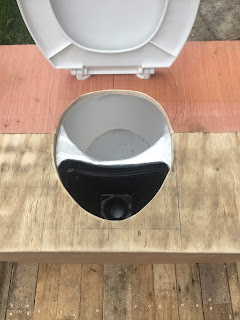It's a dirty job.
There’s no way of escaping it, the call of nature affects us all and dealing with bodily waste is something that we all have to do. Nobody likes heading into the woods to be confronted with old toilet paper or worse; so disposing of your waste responsibly is an important part of protecting our environment and keeping yourself healthy as well as being a responsible person. After answering the call of nature, it’s essential to take extra care to wash your hands and to avoid touching clean water sources with dirty hands. The major thing you want to avoid when disposing of waste is contaminating any water source. Dispose of your waste by burying it in a hole around six to eight inches deep around 200ft (60 meters) away from any water source is the ideal. Obviously, that’s dictated by your environment but use your common sense and certainly don’t go right near your camp.
 |
| My DIY separator |
The issue of smells from waste disposal is caused by the combination of urine and faeces (that curry you had the night before is going to cause a smell but it's temporary compared to the long term lingering smells). So I’ve been looking at options and these seem to boil down to four main options.
Option 1: Long drop, there are several designs but essentially its a hole in the ground that you use until it’s full, there is limited composting that takes place as no additional cover material is added, so generally its going to fill up and at that point you're going to need to move your toilet from above it, backfill your hole and then dig another. Positives are that depending on the hole size you don’t have anything to do except fill it in at the end. Negatives are that there is no urine separation and you're going to get unpleasant smells as a result. The main issue for us is that it's not suitable for clay soils where water builds up in the hole and results in floating sewage and anaerobic breakdown (that smells). Not ideal for our soil type, which has a lot of clay. Moving the toilet building around could also be an issue in the future.
Option 2: the composting toilet, lots of designs and options in this space, essentially you deposit into a receptacle and cover your waste with suitable natural material like sawdust, leaves, earth etc that will see it start to break down. You separate the urine from solid waste so there should be limited smells and it should compost down to harmless material (provided the right temperature is reached). Main drawbacks are that the receptacle will fill up over time and will have to be emptied (you can just stick the lid on the container and leave it), size and amount of usage will dictate how often this needs to be emptied (or the bucket replaced). Positives are that’s its simple to operate, you can make these quite easily (or buy specific components), the building can remain in place and you're not directly contaminating the ground, so suitable for all soil types.
Option 3: The septic tank system, waste is moved into a series of holding tanks, eventually working its way through these before it drains away through leach fields at the end of the system into the ground. Main positives are that the system can run for a long time but it's more complex and requires a fair amount of setup and digging, as these systems are normally buried. That creates issues if the system does not work as planned and might need some cleaning out in the future. Given that we have lots of trees, digging this type of system is not ideal.
Option 4: The tree bog. A kind of combined long drop and composting loo. The toilet is raised above the ground and the sides fenced off (to keep animals out and hide the pile of poo), waste falls onto the top of the soil, you add your composting material to the pile under the building and this breaks down over time. You plant trees such as willow around it and this helps absorb the composting material. Basically a composting toilet you add directly to. I’ve not seen many negatives listed but flies might be one, and if it starts going wrong you’ll be faced with a big pile of waste to move that’s right under your building. but the key advantage would be no emptying of a container. We have this type of toilet on the Wayer course.
So, after much reading and contemplation, I’ve decided on option 2, building a composting loo. I can always turn it into a tree bog if I decide it's not working out.
Watch this space to see how the build is going.

Comments
Post a Comment